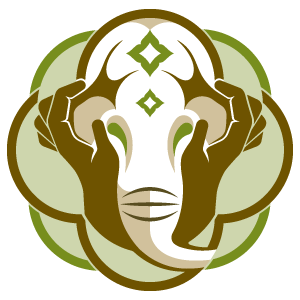Dr. Stremme discussing treatment strategies with Mr. Kan
AUGUST-SEPTEMBER 2019
With the funding of Asian Elephant Support the ECC was able to cooperate with Veterinarian Dr. Christopher Stremme for another year, and purchase new equipment for the ECC Elephant Hospital.
During Dr. Stremme’s last visit, the3 ECC staff worked on monitoring one of the female elephant (Mae Khram Ohn)’s pregnancy. The staff reviewed different birth protocols and created a new version that fit the ECC facilities and management. Dr. Stremme and ECC staff reviewed all the equipment and drugs at the ECC hospital to ensure everything ready for an emergency during the birthing process.
Since Dr. Stremme doesn’t live in Laos, the ECC staff made a delivery plan which required daily monitoring of the progesterone levels of the pregnant female elephant. Once progesterone levels significantly dropped, the ECC staff would contact Dr. Stremme immediately.
As planned, Dr. Stremme was called when progesterone levels dropped to baseline. He was able to come right before the delivery. Unfortunately, the baby was malpositioned and was stuck in the birth canal, so it was a bad case of dystocia. Dr. Stremme recommended surgical removal of the calf because the life of the mother was at high risk. The surgery was done by Dr. Stremme and the calf (that was already dead) was successfully removed from the mother.
Three weeks later, Dr. Stremme came back to the ECC to check the incision, re-suture the surgical opening, and evaluate the recovery of Mae Khram Ohn. The elephant is recovering well.
The surgeries were a difficult test for the ECC staff as they needed to perform catheter placement, provide intra-venous drugs/ fluid administration, learn techniques to restrain the elephant during surgery, and coordinate between all the staff members involved in the surgery
Training ultrasound
Ana Belen Lopez Perez preparing the elephant for ultrasound examination
Dr. Stremme trained ECC staff to perform ultrasound checks. In his previous visits, he did the ultrasounds and the staff tried to recognize the different parts of the reproductive anatomy of the females. However, in his last visit in September, the staff handled the probe and performed the ultrasound. In these sessions, the staff tried to find and identify the parts of the reproductive system. Dr. Stremme supervised the work at all times.
Pharmacy workshop
The ECC staff had many questions concerning drug dosage and storage, when to administer different drugs, what drugs can be combined together, etc. Dr. Stremme and ECC staff worked at the ECC pharmacy to review all of this. They also reviewed how to clean and disinfect surgical tools and how to store them properly.
Microscope
Thanks to Asian Elephant Support, the ECC was able to purchase a new microscope for the ECC Elephant Hospital. The ECC also purchased a camera so it will be easier to train staff to identify blood cells, fecal parasites, etc.
When Dr. Stremme was at the ECC, he held a short workshop about fecal parasite and egg identification. The staff prepared the samples and identified the different eggs under the microscope. ECC staff member Kan showed a talent for identifying the different kinds of parasite eggs!
Testing the scale
The ECC made a new platform for the scale; the new platform is metal and is lighter than the previous one made in wood.
Plan for future visits
Continue to train ECC staff (Anabel and Kan) to perform ultrasounds check on male and female elephants.
Continue parasite identification and quantification under the microscope.
Continue pharmaceutical training for Kan (drugs administration, dosage, when to administer each drug).
Organize mahout workshops at the ECC.
Continue to check the breeding females through ultrasound.
Monitoring male elephants through ultrasound by evaluating testicle size, ampullae, and seminal vesicles.



